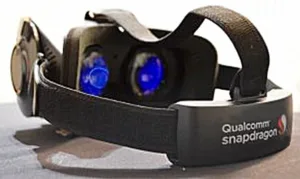Qualcomm debuted the company’s Snapdragon 835 VR Developer Kit (VRDK) headset at the recent GDC 2017 (Game Developers Conference). The headset is not a consumer device. Rather, the VRDK is primarily intended to serve as a reference design that will allow app developers an early opportunity to begin creating content that will run on devices based on Qualcomm’s latest Snapdragon mobile processor.
Perhaps the most prominent feature of the new headset is the absence of connecting wires. The headset is not tethered to a PC or mobile device. The wearer is able to freely move around the room. (Which engenders its own challenges!)
The headset contains 4GB of RAM and 64GB of internal storage. These capacities are represented as sufficient for content intended for mobile VR and tetherless headsets.
The display within the headset has a resolution of 2560 x 1400. In an on-line review published by Techradar, this is reported to provide the wearer with a crisp image, without the ‘screen door’ effect sometimes seen in smartphone-based headsets.
The Snapdragon 835 VRDK features so-called foveated rendering. With this technique, a high resolution image is presented to the area where it is determined that the wearer is looking. The image presented to the balance of the field of view is at a lower resolution. This approach is used so as to provide the wearer with a high quality image while, at the same time, reducing computation and power consumption. The on-line review reports that the technique seemed to be visually effective and that there was no noticeable lag in the adjustment of the resolution as the wearer moved their eyes.
The headset is reported to fit comfortably on the head of the wearer. The VRDK incorporates motion tracking with six degrees of freedom. Spatial audio is included to enhance immersiveness. The headset can operate about two and a half hours given a fully charged battery.
Another major feature in the headset was the inclusion of animations of the wearer’s hands. This enables interaction by the wearer with digital objects. The point to note is that the interaction is accomplished without the need for the wearer to use gloves, controllers or other device for input. The means used to implement this capability includes cameras in the headset and tracking technology from Leap Motion Inc. (San Francisco, CA). Perhaps the principle criticism of this means of interaction with digital objects is the absence of any type of haptic feedback, which is possible, at least in principle, with physical input devices.
At GDC 2017, Qualcomm used demos to show off the capabilities of their new chip and the headset’s Leap Motion hand tracking. The first demo was a simple game in which the wearer is “in a space-type setting surrounded by geometric blocks.”
An avatar of the wearer’s hands is able to manipulate the blocks. The Techradar evaluation reports that, during the minutes-long demo, there was only the slightest lag between what the wearer was doing with their real hands and what took place in the virtual world.
A second demo provided a somewhat greater challenge to the headset. In this case, the report indicates that the wearer experienced occasions when their hands seemed to move too fast for the system with the result that the wearer was unable to properly interact with the blocks.
The Snapdragon 835 VR Developer Kit is planned to ship during the second quarter of this year. Qualcomm has not yet announced a price. -Arthur Berman

